THE KITE RUNNER Arizona Theatre Company Play Guide 1
THE KITE RUNNER Arizona Theatre Company Play Guide 1
THE KITE RUNNER Arizona Theatre Company Play Guide 1
Create successful ePaper yourself
Turn your PDF publications into a flip-book with our unique Google optimized e-Paper software.
<strong>THE</strong> <strong>KITE</strong> <strong>RUNNER</strong><br />
GHILZAI<br />
experiences. It sort of validated my experience, allowed me to speak about it. And because<br />
a lot of people had read the book they could comprehend what I was saying, whereas I<br />
think prior to that it was so outlandish that I felt, in a way, awed talking about what it was<br />
like to be an immigrant – how we got here and the challenges that we faced. So I feel that<br />
it’s opened up the world for a lot of us immigrants where it’s allowing us to tell our stories<br />
and share our experiences. And it’s part of history and I think that’s how people learn and<br />
hopefully prevent these things in the future.<br />
JB: It’s such a great point about the story about how really unique and special it is in that<br />
regard and how it’s changed a lot of people’s experiences around the country and around<br />
the world.<br />
HG: I was actually really good friends with his [Khaled’s] sister when I was young and<br />
then we lost touch. When I read the book I sent him an email telling him thank you for<br />
telling my story. It’s funny because for many people that’s not a component of the story<br />
that resonates with them. But for me, as an Afghan immigrant, that was such a big part of<br />
the book. So he [Khaled] and I reconnected and have stayed in touch since then.<br />
JB: You bring up something so interesting about the book is that it is so specific in telling<br />
the Afghan-American immigrant story that hadn’t really been told before and then at the<br />
same time, it manages to be incredibly universal. The book does something that so few<br />
novels are able to do and that’s a really wonderful thing. My last question for you is what<br />
was most important for you to impart to the audience, actors and design team about<br />
Afghan culture<br />
HG: I wanted people to see the richness of the Afghan culture. I feel that the play really<br />
captures that through showing the progression of one family from where they are in Kabul<br />
and what happens to them. It really does an amazing job of telling the Afghan story in a<br />
very culturally respectful way. The costumes are beautiful and just<br />
gorgeously done. Kish and I worked very hard to make sure that,<br />
not only are they culturally accurate, but they’re time sensitive. I<br />
feel like sometimes in some things done on Afghanistan they slap<br />
somebody with a traditional outfit but it’s not fitting of what is<br />
happening. The set design is very simple but just beautifully done<br />
and I feel that it really captures the essence of Kabul. And the one<br />
other person who really brings the true essence of our culture<br />
and the culture’s love of music is the tabla player, Salar Nader.<br />
He infuses this amazing energy into the play that takes you back<br />
to Kabul – it takes you around the world. Music has been a very<br />
big part of the Afghan culture for a long time and unfortunately it<br />
was muted during the time of the Taliban. So having the live tabla<br />
player really captures the richness and the diversity of the Afghan<br />
culture and the country.<br />
- Questions created by Laura Farrell-Wortman, dramaturgical intern<br />
Salar Nader in The Kite Runner.<br />
Photo by Kevin Berne.<br />
<strong>Arizona</strong> <strong>Theatre</strong> <strong>Company</strong> <strong>Play</strong> <strong>Guide</strong> 32







![Play Guide [356k PDF] - Arizona Theatre Company](https://img.yumpu.com/46218320/1/190x245/play-guide-356k-pdf-arizona-theatre-company.jpg?quality=85)
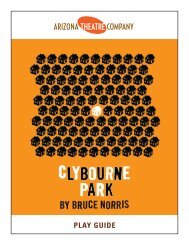
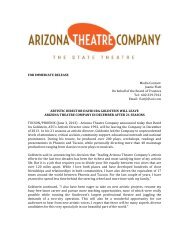

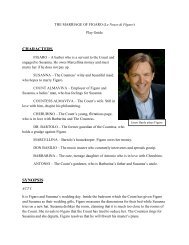
![[title of show] Arizona Theatre Company Play Guide 1](https://img.yumpu.com/24482689/1/190x245/title-of-show-arizona-theatre-company-play-guide-1.jpg?quality=85)
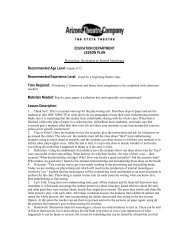
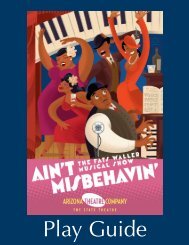
![Play Guide [1.2MB PDF] - Arizona Theatre Company](https://img.yumpu.com/11952176/1/190x245/play-guide-12mb-pdf-arizona-theatre-company.jpg?quality=85)
